Having a washing machine in the basement presents unique challenges, particularly concerning drainage. A properly functioning pump is crucial to prevent flooding and ensure smooth operation. This guide will help you understand the different types of pumps available, factors to consider when choosing one, and how to install and maintain them.
What Kind of Pump Do I Need for My Basement Washing Machine?
This is often the first question homeowners ask. The answer depends on your specific situation, mainly the distance the water needs to travel and the height it needs to be lifted. Generally, you'll need a sump pump or a laundry pump.
-
Sump Pumps: These are designed to handle larger volumes of water, often used for basement flooding prevention. If your basement is prone to flooding, a sump pump might be a good choice, offering broader protection beyond just your washing machine. They're more powerful but also typically more expensive.
-
Laundry Pumps: These are specifically designed for washing machine drainage and are usually smaller and less powerful than sump pumps. They're ideal if your washing machine drainage is the only concern and you don't anticipate significant basement flooding.
How High Does My Washing Machine Pump Need to Lift Water?
The height the pump needs to lift the water, known as the head, is crucial. This depends on the distance between your washing machine drain and the drainpipe or sewer line. Manufacturers specify the maximum head their pumps can handle; choosing a pump with sufficient head is vital to prevent backflow and potential flooding. Measure the vertical distance carefully and choose a pump with a head rating exceeding this measurement.
What is the Best Type of Pump for a Basement Washing Machine?
There's no single "best" type; the ideal pump depends on your specific needs. Consider these factors:
- Water Volume: How much water does your washing machine produce per cycle? A higher-capacity pump is needed for larger washing machines.
- Distance to Drain: How far is the washing machine from the drain line? A longer distance requires a pump with more power.
- Vertical Lift (Head): As discussed above, this is crucial.
- Budget: Sump pumps tend to be more expensive than laundry pumps.
- Maintenance: Consider the ease of maintenance and parts availability.
How Do I Install a Washing Machine Pump in My Basement?
Installing a pump varies depending on the type. Always consult the manufacturer's instructions. Generally, it involves connecting the pump to the washing machine drain hose, then connecting the pump's discharge hose to the drain line. Proper venting is also critical to prevent clogs and ensure efficient operation. It's recommended to consult a plumber if you are unsure about any aspect of the installation.
What Happens if My Washing Machine Pump Fails?
A failed pump can lead to a flooded basement. Signs of pump failure include slow drainage, gurgling noises, or the pump running continuously without draining water. Immediate action is crucial; contact a plumber to repair or replace the pump to prevent further water damage.
How Often Should I Maintain My Washing Machine Pump?
Regular maintenance extends the life of your pump. This includes checking the pump for clogs regularly, cleaning the pump impeller, and ensuring proper ventilation. The frequency depends on usage, but a yearly inspection is recommended.
Can I Use a Regular Sump Pump for My Washing Machine?
While you can use a sump pump, it might be overkill and unnecessarily expensive for just washing machine drainage. A laundry pump is typically a more appropriate and cost-effective solution unless you have other basement flooding concerns.
Choosing the right pump is a crucial step in ensuring your basement washing machine operates smoothly and safely. Remember to prioritize safety and consult with a professional plumber if you're unsure about any aspect of installation or maintenance. Proper planning and installation prevent costly repairs and potential water damage.
